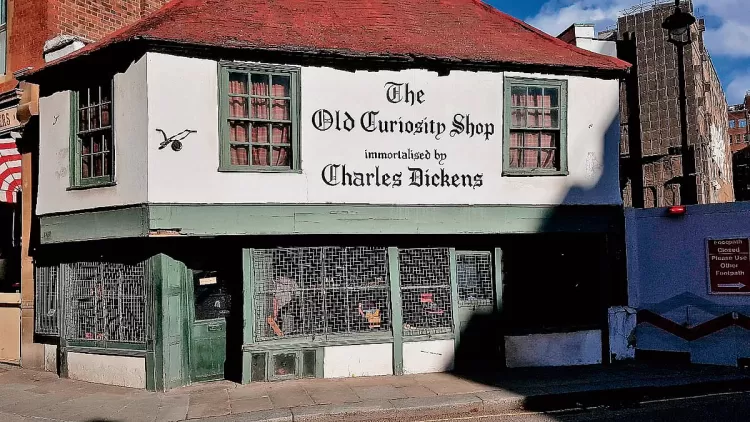Footsteps in a tale of two Cities
London’s literary landscape is littered with unforgotten words. Some real, some the stuff of legends. During a Bloomsbury pub walk, the English literature buff can see the plaque on 221 Baker Street, which is an imaginary address although the Sherlock Holmes Society says otherwise. The Conan Dyle tour takes you to the very hotel his wedding reception was held and a site where he solved a real-life detective case. But perhaps no other author has identified himself with London than Charles Dickens. Dickensian London was in the Victorian era of contrasts between extreme opulence and drab poverty. He called the city as a "magic lantern," a highlight of the Victorian era which used projectors to show slides of the city.There was the market Covent Garden, the site of Oliver Twist and The Pickwick Papers. The Staple Inn square in Holborn finds mention in The Mystery of Edwin Drood. The bells that ring in the clock tower of St. Dunstan-in-the-West Church peal in A Christmas Carol. In a letter

London’s literary landscape is littered with unforgotten words. Some real, some the stuff of legends. During a Bloomsbury pub walk, the English literature buff can see the plaque on 221 Baker Street, which is an imaginary address although the Sherlock Holmes Society says otherwise. The Conan Dyle tour takes you to the very hotel his wedding reception was held and a site where he solved a real-life detective case. But perhaps no other author has identified himself with London than Charles Dickens. Dickensian London was in the Victorian era of contrasts between extreme opulence and drab poverty. He called the city as a "magic lantern," a highlight of the Victorian era which used projectors to show slides of the city.
There was the market Covent Garden, the site of Oliver Twist and The Pickwick Papers. The Staple Inn square in Holborn finds mention in The Mystery of Edwin Drood. The bells that ring in the clock tower of St. Dunstan-in-the-West Church peal in A Christmas Carol. In a letter to close friend John Forster in 1869, he wrote that “a day in London sets me up and starts me”. Born in Portsmouth on February 7, 1812, Dickens spent his early childhood in Chatham, Kent. “He then lived in Borough and Holborn, shifting to Marylebone after he became renowned as an author,” says Charlie Lakerman, a Dickensian walking tour guide. “The geographical locations—inns, graveyards, country houses, villages and the gritty streets of London have changed since his time, but are easy to find in his fiction,” he adds.
The Life and Adventuresof Nicholas Nickleby is alive in quaint pubs, alleyways, and cloistered courtyards. Most of these are a two hour's walk, around the Big Ben and where the Thames flows.
Richard Jones, who runs Dickens tours and is also the author of Dickensian London, begins a few of his tours from the surviving wall of Marshalsea Prison, where Dickens found “... the crowding ghosts of many miserable years...”. At the height of his fame, Dickens often chose to eat at Rules in Covent Garden. The oldest restaurant in London reserved a table for him that overlooked the blacking factory where he had worked as a child.
The young Dickens often headed to a pub for a spot of inspiration along with a drink. His favourites were George and Vulture, where an inn has been in existence since 1268; The George, appears in Little Dorrit and is London’s only remaining galleried coaching inn, and Ye Olde Cheshire Cheese, a 345-year-old pub on Fleet Street. Other Dickensian locations include Staple Inn Square, of the Mystery of Edwin Drood; Southwark Cathedral, where he attended ringing practice in 1869; the bank that employed Jerry Cruncher in A Tale of Two Cities; and Mr Tulkinghorn’s chambers in Bleak House where “lawyers lie like maggots in nuts”. The Old Curiosity Shop, believed to be the oldest shop in Central London, is a tourist magnet. The uneven-beamed structure, which dates to the 16th century, is said to have been the inspiration for the eponymous novel that Queen Victoria found “very interesting and cleverly written”.
Many Dickens-focused walking tours also take in Seven Dials, then a slum of “dirty men, filthy women, squalid children … reeking pipes … depressed dogs”. His books reveal empathy for the underclass, identifying with poverty-stricken Victorian London.
All Dickensian tours begin or end at 48 Doughty Street, his only remaining family home in London. The Grade I listed building now houses the Charles Dickens Museum. A comprehensive collection of about 100,000 items, including letters, manuscripts, rare editions, prints, photographs, and personal effects, are on display.
Till June 30, 2025, the museum will run Dickens in Doughty Street: 100 Years of the Charles Dickens Museum. Cindy Sughrue, the museum's director says, the exhibition will feature historic items that have been “gathered together over the past century” and “define Dickens’ life and the museum’s history”. London may have changed since Dickens’ time, but he looked at it “in a very original way”, making it the “chief character in his work”, writes Andrew Sanders, in his book book Charles Dickens’s London that traces Dickens’ footsteps. Like Oliver Twist, you’ll end up asking for more.
















